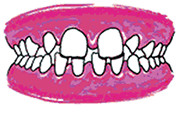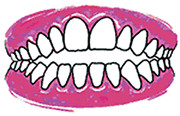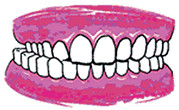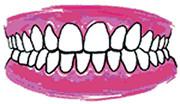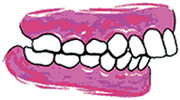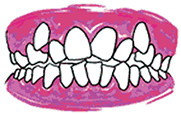A solution in the case of tooth or jaw deficiencies at any age.
Our specialist orthodontist, Dr. ALTAY Zoltán M.D., is the right person to contact if you suffer from dental or facial irregularities that must be corrected by braces.
|
Dr. Altay Zoltán |
Orthodontists first graduate as dentists, but continue their medical studies for several years as oral surgeons specialized in Oral and Maxillofacial Surgery (OMS). If there is a deviation of the position of teeth and/or jaws, the best solution is provided by orthodontics: with orthodontic braces, retainers or cases specialized orthodontists are able to assist you in shaping your teeth and/or jaws. You should remember that orthodontics is not a treatment that any dentist would be able to perform. For each complicated malocclusion or jaw misalignment there is a given type of orthodontic appliance to solve it, so you are advised to consult an orthodontist who specializes in corrections of such irregularities. Misalignments include underbites, malocclusions, overbites, open bites, deep bites, cross bites, crooked teeth, and various other flaws of the teeth and jaw. |
At our Institute you and your children have the opportunity to receive a treatment plan according to the most modern technology, which aims to influence your daily life reasonably well.
As a member of our dentist team, Dr. ALTAY Zoltán M.D. being an excellent specialist in orthodontics carries out treatments both for adults and children. Dr. ALTAY Zoltán M.D. awaits you and your children for a consultation in building Nr. 1 of Diamant-Dent Dental Medical Institute!
Our 3D digital Picasso Trio CBCT X-ray machine opened new dimensions in the fields of orthodontics as well. It includes digital cephalometric system so our specialists can make a Cephalometric Scan which will be analysed by our Smile programme. Thus a much more precise diagnosis and plan can be carried out.
| before | after |
|
|
|
|
|
|
|
|
|
|
|
|
|
|
|
|
|
 |
|
|
|
|
|
|
|
|
|
|
|
|
|
|
|
| Irregular stances of teeth | |
|
gap |
openbite |
|
crossbite |
shifted middleline |
|
protruding upper jaw |
crowding |
|
progenia |
progenia |
|
deepbite |
|
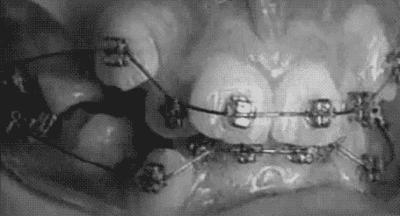
Lingual orthodontics
The lingual method is the most known and most effective sort of invisible orthodontics.
The retainer is glued on the inside of the teeth, so that he is invisible while smiling or speaking. The principle of this treatment is similar to retainers on the outside: brackets with clasps will be glued.
The brackets must be made for all teeth specially, because the tooth inside (in opposite to the tooth outside) has another form by us all. The same applies to the clasp.
Therefore, we invite you gladly to an appointment, while our orthodontology-specialist makes a treatment plan based on X-rays and imprints.
Download pdf.


Orthodontics - Frequented asked questions
Which is tooth adjustment actually?
Orthodontics is a relatively new area of medical science. Those nowadays as orthodontics known procedures were only accepted and accomplished about 100 years ago. The procedure is concentrating mainly on the resitution of the irregularities of the teeth in regard of the position in the jaw, regular control of these irregularities and on the unproportional growth of the jaw to each other and eventual generally matters of this genre. Further, problems can be repaired with the control of functional problems - which is devoted from irregular contact or position of the teeth - and aesthetic problems. In the infancy, when the child is still growing, one can be able to control the growth of the face bones for the reaching of the optimal tooth contacts later. (Jaw-Orthopedics) In addition a harmonic shape of the face can be achieved.

In the adult age the possibilities compared to the treatments which can be done in the childhood are reduced. The growth of the two jawbones cannot be used as an instrument any more, but there exists - even if only limited - with the strict adherence of some rules a chance for the healing of the irregularities. It is an old misunderstanding, that at the adult age must be lived with an unaesthetic smile, because the teeth are not fitted for an orthodontic treatment any longer. Orthodontics does not actually have age limits, treatments can also be made with the age of 60 years.
How does it function?
The teeth are firmly embodied in the bones with the help of the so-called root - membrane. This ensures a stable, but in small amonunts felxible base.
In the fabric of the roots are vessels and nerves. The vessels gets lost is crosswise from the root to the bone to which the tooth fastened. The small vessels obtain the drawing and thrust forces on the bone. On the effect drawing strength forms a microscopic multi-substance at bones, on the effect pressure strength takes place a microscopic bone illustration.
Thus moves the tooth with a very slow speed in the foreseen direction with exercised strength. In simplified form the movement of the teeth leaves itself by practice strength can be explained in such way.

With a similar mechanism the growth of the lower and upper - jaw can be affected. This demands far more comprehensive knowledge and one far more comprehensive armament, because the human head is very complicated developed and therefore fell the influence of its growth many more heavily. Strength, the teeth to be moved, are mediated to along that by a removable tooth adjustment.
When should be orthodontical treatment begun and what should be regarded?
With respect to regard of the formation of the teeth/dentures comes three separated dentures to be differentiated: milk dentures, mixed dentures and remaining dentures.
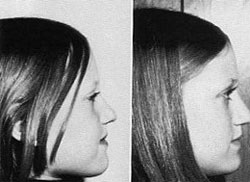 The departure of the milk teeth catches with the age of 6 months and is terminated with the age of 24 - 30 months. Pass no further events to the age of 3 - 3.5 years. Then, with the age of approximately 6 years the first 6 - it teeth - appears the large molars. These are remaining teeth. Starting from the time is counted those period of the mixed dentures. The tooth changing begins with the age of approximately 7 years, with the loss of the frontal teeth. The loss of the grinder and the cutting teeth take place all in the course of the mixed dentures period. The period is the most important stage in the tooth adjustment, since in the time most deformations can be corrected. Deformations can be treated also later, but only more with compromise. Fact is however that that can be achieved most beautiful result by the at the beginning of the treatment at this age - at age of the mixed dentures -. The period of the mixed dentures ends itself, if the last milk teeth fell out because of pressure of the final tooth. This arrives approximately at the age of 10 years. Of course considerable deviations from the indicated numbers can occur, since we are all different.
The departure of the milk teeth catches with the age of 6 months and is terminated with the age of 24 - 30 months. Pass no further events to the age of 3 - 3.5 years. Then, with the age of approximately 6 years the first 6 - it teeth - appears the large molars. These are remaining teeth. Starting from the time is counted those period of the mixed dentures. The tooth changing begins with the age of approximately 7 years, with the loss of the frontal teeth. The loss of the grinder and the cutting teeth take place all in the course of the mixed dentures period. The period is the most important stage in the tooth adjustment, since in the time most deformations can be corrected. Deformations can be treated also later, but only more with compromise. Fact is however that that can be achieved most beautiful result by the at the beginning of the treatment at this age - at age of the mixed dentures -. The period of the mixed dentures ends itself, if the last milk teeth fell out because of pressure of the final tooth. This arrives approximately at the age of 10 years. Of course considerable deviations from the indicated numbers can occur, since we are all different.
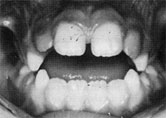 While the period, the individual has still milk teeth, is an intervention rather seltend compelling. During this time one must give more attention on the jaw with extreme sizes and on the associated turned contact of the cutting - teeth (whereby the lower teeth take over the upper). Important is also noticing an open bite. A small gap beside the frontal teeth can be discovered. One must mention, that in case of a small lower jaw, even if rarely, a jaw - orthopediecs must take place.
While the period, the individual has still milk teeth, is an intervention rather seltend compelling. During this time one must give more attention on the jaw with extreme sizes and on the associated turned contact of the cutting - teeth (whereby the lower teeth take over the upper). Important is also noticing an open bite. A small gap beside the frontal teeth can be discovered. One must mention, that in case of a small lower jaw, even if rarely, a jaw - orthopediecs must take place.

The bad habits (licking of the fingers etc) can be treated successfully in this age. Treatment of birth irregularities such as wolf neck, hare lips, can be continued in the period, although the treatment is already begun with the age of 3 months (a complex surgical and orthodontical treatment can cover) and it ends only with the reaching of the age of 18 - 20 years of age. Into the physician team associate ear and nose physicians, child physicians, surgeons, prothetic dentists and psychologist.
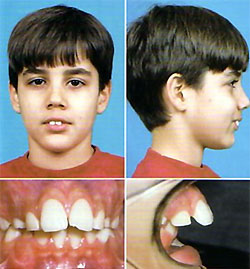 The period of the mixed dentures (age of 6-7 years) is the best recommendable for a consultation about tooth adjustment or braces. If something should be present of normal deviating, this can be uncovered by the specialist. Beside the here enumerated further deformations and irregularities (tooth stagnations, tooth spacings, columns between the frontal teeth, low dentures and the slow growth of the lower jaw and related deformations) can be treated with success.
The period of the mixed dentures (age of 6-7 years) is the best recommendable for a consultation about tooth adjustment or braces. If something should be present of normal deviating, this can be uncovered by the specialist. Beside the here enumerated further deformations and irregularities (tooth stagnations, tooth spacings, columns between the frontal teeth, low dentures and the slow growth of the lower jaw and related deformations) can be treated with success.
In the remaining dentures man can accomplish treatments of most diverse kind, but the possibilities are limited, since do not know the influence of the direction and the measure when support are useful. For example one can mention the following case: One takes 15 a year old, male patient, who has arranged teeth on the first view perfectly, but when biting it turns out that that is lower jaw far in the back. Due to this, the upper cutting - teeth will lay over the lower ones and bite on the gums. This is how deep - bite is forming.
An investigation is certainly needed for the statement of the problem. In that above-mentioned case one must move the 6 frontal teeth with a planned back move.
However one must create place, therefore the first molars are removed, since there are no further alternatives to the place creation at this age. Then only a firm instrument for the outmoving of the teeth can be used.
All this would have be done before the patient reaches the age of 5 years, in order the removable instrument can achieve successes.
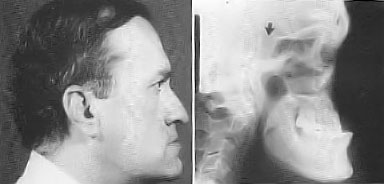 In the remaining dentures one treats all irregularities, which were already treated before, but over-remained due to that extent of the deformation and further circumstances further tasks of treatment for the period the continuousremaining dentures. Finally at the adult age, minimum with the age of 18 years separate problems of specially-common growth can arise, which could not have been treated by orthodontical ways. Here can surgacal measures be
In the remaining dentures one treats all irregularities, which were already treated before, but over-remained due to that extent of the deformation and further circumstances further tasks of treatment for the period the continuousremaining dentures. Finally at the adult age, minimum with the age of 18 years separate problems of specially-common growth can arise, which could not have been treated by orthodontical ways. Here can surgacal measures be
Removable- and fixed instruments
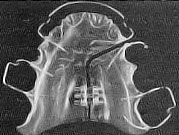 There are lots of different types of removable instruments, whereby one must mention the plates and blocks. Plates are fastened only on one jaw, blocks on both. The attachment mostly happens by wires lashed on the teeth, but there are such instruments, which are fastened to the soft tissue. After we have fixed instrument - which is made of plastic in most diverse colors -, can screws, small feather/spring be installed here, so that the most diverse tasks can be accomplished. With screwing the two sides of the jaw, teeth can be pushed together or apart for example. Of course planning and execution the procedure require competent knowledge and experience, since the orthodontologycal doctor must see in the head the whole procedures in advance. There are no treatments, whereby the steps are planned individually, successively, in consideration of the newly occurred condition.
There are lots of different types of removable instruments, whereby one must mention the plates and blocks. Plates are fastened only on one jaw, blocks on both. The attachment mostly happens by wires lashed on the teeth, but there are such instruments, which are fastened to the soft tissue. After we have fixed instrument - which is made of plastic in most diverse colors -, can screws, small feather/spring be installed here, so that the most diverse tasks can be accomplished. With screwing the two sides of the jaw, teeth can be pushed together or apart for example. Of course planning and execution the procedure require competent knowledge and experience, since the orthodontologycal doctor must see in the head the whole procedures in advance. There are no treatments, whereby the steps are planned individually, successively, in consideration of the newly occurred condition.
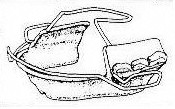 Beside the enumerating one can settle another important task with blocking (so-called bimaxilary - instruments on both jaws, which are fix fastened): Jaw - orthodontical treatment. Thereby the teeth cannot only be adjusted, but an influence on the growth of the bones can be exerted. This is to be carried out however only in the period of the mixed bite.
Beside the enumerating one can settle another important task with blocking (so-called bimaxilary - instruments on both jaws, which are fix fastened): Jaw - orthodontical treatment. Thereby the teeth cannot only be adjusted, but an influence on the growth of the bones can be exerted. This is to be carried out however only in the period of the mixed bite.
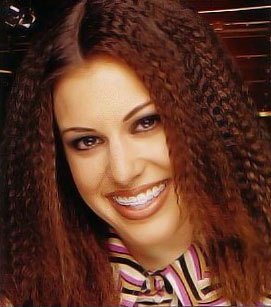 There is well-known numerous types of the fastened instruments. Here we will mention only one instrument, which is usually prefered: Multi-volume - instrument. This consists of small schloes glued on each tooth. Schloes can be made of metal, plastic, ceramic. At the end of the treatment that can be removed adhesive naturally without damages of the tooth - substance. In this small schloes we fix a small, flexible wire. Wire is connected to schloes and the flexible strength existing in the wire move the teeth in the intended place.
There is well-known numerous types of the fastened instruments. Here we will mention only one instrument, which is usually prefered: Multi-volume - instrument. This consists of small schloes glued on each tooth. Schloes can be made of metal, plastic, ceramic. At the end of the treatment that can be removed adhesive naturally without damages of the tooth - substance. In this small schloes we fix a small, flexible wire. Wire is connected to schloes and the flexible strength existing in the wire move the teeth in the intended place.
One uses wires of most diverse kind, with different flexibility and volume. The best suitable wire is selected by the specialist. These wires are connected to the clips, which are used for the movement of the tooth. Further one can interconnect the schloes from two teeth with most diverse elements, like e.g.: Rubber bands. Thus two teeth can be attached. These parts must be carefully planned - as well as with the removables -, since basic rule of the tooth adjustment is that teeth cannot be moved without effect on another. The prevention of such event is very important, therefore is an accurate, exact planning of the treatment of great importance. The multi-volume - appliance is used in the age of the mixed teeth by the American orthodontologists, but also in the period of approximate age of 8 years. The right begin of the treatment would be at the begin of the remaining - teeth.
What is treated during the infancy?
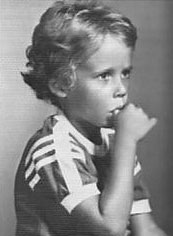 In the period of the milk tooth dentures must be made interventions very rarely. Here one must pay attention to the extreme-increased lower jaw (and the circumstance connected firmly with the condition reverse contact of the frontal teeth). Important with it is also the recognition of a "open bite": In this case a column is to be recognized between upper and lower frontal teeth in the closed condition. One must mention the clearly more seeable very small lower jaw, since it can - even if only rarely and in particular - heavier cases - result ina n orthopedical treatment. The bad habits (licking of the finger, wrong swallowing with the use of the tongue) let themselves eliminate in this age. The treatment of birth irregularities such as wolf neck, hare lips, can be continued in the period, although the treatment has already begun with the age by 3 months (a complex surgical and orthodontical treatment covers) and ends only with the reaching of the age of 18 - 20 years. Into the physician team associate ear and nose physicians, child physicians, surgeons, prosthetic dentists and psychologists.
In the period of the milk tooth dentures must be made interventions very rarely. Here one must pay attention to the extreme-increased lower jaw (and the circumstance connected firmly with the condition reverse contact of the frontal teeth). Important with it is also the recognition of a "open bite": In this case a column is to be recognized between upper and lower frontal teeth in the closed condition. One must mention the clearly more seeable very small lower jaw, since it can - even if only rarely and in particular - heavier cases - result ina n orthopedical treatment. The bad habits (licking of the finger, wrong swallowing with the use of the tongue) let themselves eliminate in this age. The treatment of birth irregularities such as wolf neck, hare lips, can be continued in the period, although the treatment has already begun with the age by 3 months (a complex surgical and orthodontical treatment covers) and ends only with the reaching of the age of 18 - 20 years. Into the physician team associate ear and nose physicians, child physicians, surgeons, prosthetic dentists and psychologists.
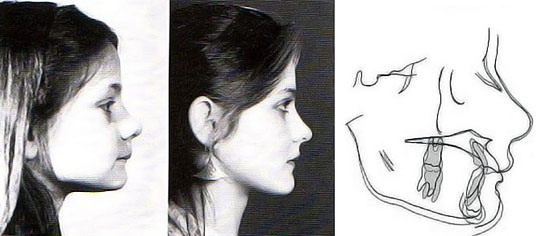
The period of the mixed dentures (age of 6-7 years) is the best recommendable for a consultation over tooth adjustment. If something should be present of normal deviating, this can be uncovered by the specialist. Beside enumerated the here further deformations and irregularities (tooth stagnations, tooth spacings, columns between the frontal cutting - teeth, low dentures and the caused slow growth of the lower jaw such as related deformations) can be treated with success. The period of the mixed dentures is the only suited period for the jaw - orthopedical treatments.
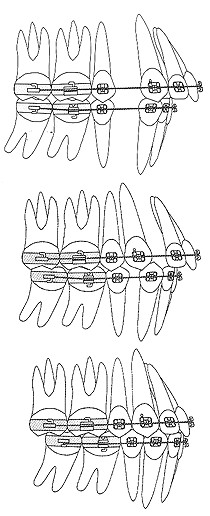 In the remaining dentures one can accomplish treatments of most diverse kind, but the possibilities are limited, since one does not know the influence of the direction and the measure when supports are useful.
In the remaining dentures one can accomplish treatments of most diverse kind, but the possibilities are limited, since one does not know the influence of the direction and the measure when supports are useful.
For example one can mention the following case: One takes 15 a year old, male patient, who has arranged teeth on the first view perfectly, but when biting it turns out that that is lower jaw far in the back. Due to this, the upper cutting - teeth will lay over the lower ones and bite on the gums. This is how deep - bite is forming.
An investigation is certainly needed for the statement of the problem. In that above-mentioned case one must move the 6 frontal teeth with a planned back move. However one must create place, therefore the first molars are removed, since there are no further alternatives to the place creation at this age. Then only a firm instrument for the outmoving of the teeth can be used.
All this would have be done before the patient reaches the age of 5 years, in order the removable instrument can achieve successes.
Jaw - Orthopedics
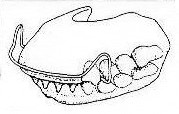 In the infancy, whereby the child is still growing up, one can affect the development of the bones strongly and with it the possibility for the creation harmonical tooth contact. (jaw - orthopedics) The period of the mixed dentures is the only suited period for jaw - orthopedical treatments.
In the infancy, whereby the child is still growing up, one can affect the development of the bones strongly and with it the possibility for the creation harmonical tooth contact. (jaw - orthopedics) The period of the mixed dentures is the only suited period for jaw - orthopedical treatments.
 In the remaining dentures one can accomplish treatments of most diverse kind, but the possibilities are limited, since one does not know the influence of the direction and the measure when supports are useful. For example one can mention the following case: One takes a 15-year-old male patient, who has arranged teeth on the first view perfectly, but when biting it turns out that that is lower jaw far in the back. Due to this, the upper cutting teeth will lay over the lower ones and bite on the gums. This is how deep bite is forming.
In the remaining dentures one can accomplish treatments of most diverse kind, but the possibilities are limited, since one does not know the influence of the direction and the measure when supports are useful. For example one can mention the following case: One takes a 15-year-old male patient, who has arranged teeth on the first view perfectly, but when biting it turns out that that is lower jaw far in the back. Due to this, the upper cutting teeth will lay over the lower ones and bite on the gums. This is how deep bite is forming.
An investigation is certainly needed for the statement of the problem. In that above-mentioned case one must move the 6 frontal teeth with a planned back move.
However one must create place, therefore the first molars are removed, since there are no further alternatives to the place creation at this age. Then only a firm instrument for the outmoving of the teeth can be used.
All this would have be done before the patient reaches the age of 5 years, in order the removable instrument can achieve successes.
What can be treated in the adult age?
In the adult - age all irregularities can be treated, which has not been treated in former times, or an orthodontical treatment proceed before was not successful. (a surgical intervention will be necessary for the treating of the disproportionesses of the jaw)
Uinity is to be noticed however: There is no possibility for an orthopedical solution, therefore the considerable size differences of the two jaw or the to each other measured disproportionesses must be eliminated by surgical interference or by extraction.
The most important irregularities, which we treat at the adult age: tooth stagnations, cross bites, deviations of the position individual teeth (the frontal tooth cannot emerge by the gums, because it was stuck in the bone, it will emerge, but in the wrong direction), low bite, not by orthopedical problems open bite developes. The not-treated cases can become still considerable up to the reaching of the adult age: The teeth can move themselves from their position, loosen into all possible way and therefore, they can be lost. Pain of the jaws and further unpleasant symptoms can form themselves.
To same time the dentures are inclined much more strongly at the formation of cavities and to the chronical inflammations of the gums.

Besides one does not need to mention more than in the irregular dentures is the chewing achievement and the aesthetic feature is built. Such untreated cases are suited also in the arising age for a treatment and a restoration. Of course, othe instruments can be used as well for the treatment of these symptoms.
The treatments can be accomplished with removable and with fixed-instruments. Larger tooth movements can be achieved however only with a fixed instrument.
Surgical - orthopedic solutions
At the adult age, at earliest the age of 18 years we treat such irregularities of growth, which could not have been eliminated through an orthodontical treatment, therefore they need a surgical interference. (e.g.: Bulldog-bite) In this case, the "disclaiming" orthodontical treatment of a surgical correction of the irregularities of the jaws is proceed. After renewed orthodontic treatment is needed, and provides final, stable final state with the correction of the still existing smaller positional variations. These irregularities are a special field of the Orthodontology, for their practice is a very large responsibility, expertise, experience and the professional cooperation by the face and jaw surgery is needed.
General confusions
It is a general illusion that the child "attains full growth" with the time the tooth stagnations. Parents believe that the small face continues to grow, so that a place for the teeth is created.
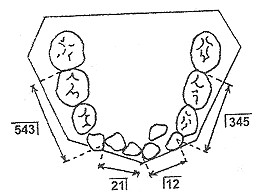 The actual facts is that the distance after reaching the age of 6 years between the first molar (tooth 6) and the two forntal teeth (tooth 1) does not grow, but reduces. During changing the teeth - which represents a very complicated mechanism - it is only a short moment, but very important. By the procedure the further place for the tooth 4 will not be missing. The largest part of the growth takes place at the age of 6 years.
The actual facts is that the distance after reaching the age of 6 years between the first molar (tooth 6) and the two forntal teeth (tooth 1) does not grow, but reduces. During changing the teeth - which represents a very complicated mechanism - it is only a short moment, but very important. By the procedure the further place for the tooth 4 will not be missing. The largest part of the growth takes place at the age of 6 years.
The childhood finger licking should be treated after completed 4th years of age, but even than is it inevitable that the child will need an orthodontic treatment. The improvement of the situation can emerge itself with smaller deformations - provided that the jaw - bone grows duly - one can talk about a rare case.
Another mistake is, that after that orthodontical treatment the results maintain and the overall view will not worsen again. Tooth adjustment consists of active part, whereby the teeth are moved (irregularities corrected) and from one retention period, whereby that is fastened reached result, in order to prevent the worsening. The retention period lasts at least so long as the active. May not be neglected, since this can destroy that whole past work.
Mistake is the beginning that it cannot be accomplished in the adult age tooth adjustment.
How long shall the instrument be carried?
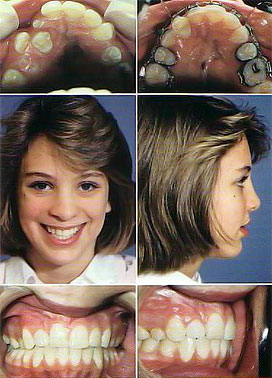 Principles can be provided despite the individuality. In the teenager - age used instrument, which has orthopedical effects, must be carried during 14 hours a day. Here one must ensure an appropriate and tidy carrying. 10 hours on the day are not sufficient. We, orthodontologists are also at the opinion that if there is no possibility for various reasons (the child treipt a sport, plays on an instrument) for carrying, treatment shall not be begun, since the damage can become larger than it was before. It can be explained with the reaction of the bones to the tooth adjustment of exerted strength: Changes can be achieved only with the practicing of permanent force. There are such deformations, which can be treated only with such bimaxillares instrument, which one must carry for several years.
Principles can be provided despite the individuality. In the teenager - age used instrument, which has orthopedical effects, must be carried during 14 hours a day. Here one must ensure an appropriate and tidy carrying. 10 hours on the day are not sufficient. We, orthodontologists are also at the opinion that if there is no possibility for various reasons (the child treipt a sport, plays on an instrument) for carrying, treatment shall not be begun, since the damage can become larger than it was before. It can be explained with the reaction of the bones to the tooth adjustment of exerted strength: Changes can be achieved only with the practicing of permanent force. There are such deformations, which can be treated only with such bimaxillares instrument, which one must carry for several years.
Many treatments consist of several parts (removable and fixed intruments). The carrying time of only removable plates can do 3 - 6 months or possibly more amounted to, depends strongly on the solving task. In this case they are however only subtasks, which are fastened (mutliband), by another instrument.
The stretcher time of the multi-volume instruments depends on the solving task. Weaker stagnations can be eliminated within 8 - 9 months. The effective treatment of the low bite, open bite and the further cases, whereby a tooth movement of larger masses had to be achieved, can last up to 18 months. In cases, where there are still heavier problems, the treatment can be still longer.
Retention, control.
After the tooth adjustment is terminated, begins the so-called retention phase. The retention phase is also with a kind of the tooth adjustment, although the phase does not bring results worth seeing with itself, but serves it as adjustment the reached result. All this is because of the two phases of the tooth adjustment. During the first phase the teeth moved (missbuildings can be eliminated), during the second phase, the return of the teeth to their original places is prevented. The second phase lasts at least so long as the active first phase. The second phase may not be neglected, since that could endanger the whole work. The possible reasons can be discovered in the root - skin and in the vessels of the gums. These stretch themselves during the tooth adjustment. Bone can reconstruct itself faster than the vessels. The small vessels can withdraw the tooth in the wrong direction. In order to be able to prevent this procedure, the teeth must be fastened, the teeth should be provided with iron stables. This happens mostly with removable plates, which are fastened to the tooth with hooks. The daily carrying of the instrument can be shortened during the treatment time with the passing of time. After the retention phase an annual control for the keeping of stability is essential.
Bad habits.
The formation of the irregularities of the dentures is a complex and various difficult procedure. One can differentiate between leave and purchased anomalies. Leave irregularities are for example the excessive size of the jaw and the teeth, low bite and much more. Acquired irregularities: To these irregularities count from prevented respiration throughout the nose respiration developed by the mouth. (therefore it is a jaw, where the position of the teeth has changed unfavorably).
The precaution of an untidy, unhealthy possibly bent attitude, which can arise due the incorrect inserting of the child bed, can be very important. The muscles, which determine the attitude of the body, are controlled by the nervous system by means of a reflex mechanism. If a wrong program should over-remain in the system, the wrongly programmed system has an effect on the growth of the jaw by means of muscles, which also determine the position of the organ. The premature tooth distances are - unfortunately - from great importance. By premature extraction of a milk tooth one understands an extraction of a milk tooth, which was made one (or more) year(s) before the outbreak of the remaining tooth. This extraction can influence the later the stand and the bite of the teeth. Even a hit on the milk - teeth can lead to the not - appearing of the remaining teeth.























